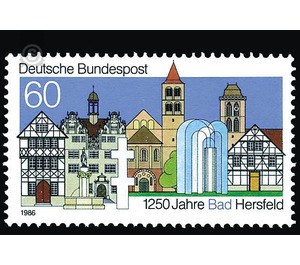1250 years Bad Hersfeld - Germany / Federal Republic of Germany 1986 - 60 Pfennig
Theme: Architecture
| Country | Germany / Federal Republic of Germany |
| Issue Date | 1986 |
| Face Value | 60.00 |
| Color | multi-colored blue |
| Perforation | K 14 |
| Printing Type | Six-color offset printing |
| Stamp Type | Postage stamp |
| Item Type | Stamp |
| Chronological Issue Number | 1144 |
| Chronological Chapter | GER-BRD |
| SID | 5164 |
| In 38 Wishlists | |
The 1,000 year old abbey ruins, the landmark of the county town of Bad Hersfeld, owes its origins to the once famous Benedictine monastery, which once (769 AD) founded Lull, the successor of Boniface on the Mainz Archbishop's chair, here in the border area to Thuringia. But a generation before Haerulfisfelt was, as the place was called, moved by the Bavarian storm in the light of history, because in 736, exactly 1250 years ago, he had settled with some companions in today's abbey district as a hermit. Charles d. Great immediately elevated Lull's founding to the rank of imperial abbey (775 AD), which for centuries was to be a major base of royal power on the eastern border of the empire. In the protection of the monastery castle developed gradually a settlement, which is first mentioned as a city in 1170. At that time, the Abbey, with its rise and decline and the fate of the young branch was inseparable, under Abbot Siegfried (1180 to 1200) at the height of their political influence. But with the downfall of the Staufer extinguished the importance of the Hersfeld monastery for the imperial history. For this, the thriving city developed an ever greater self-confidence and stormy demanded to shake off the restrictive spiritual city rule. The long-standing dispute found its visible culmination in the abortive attack of the Abbot and his allies on the townspeople on the Vitalisnacht of the year 1378. Their victory indeed gave the citizens the satisfaction of having warded off the insidious attack on their urban freedom, but both City like the pen, finally fell as an overripe fruit 1606 (in terms of realm, however, only 1648) of the county Hesse. From then on it remained quiet around Hersfeld, when it had sunk from a small princely residence to a Hessian rural town on the very edge of the landgraviate. The 30-year war had caused unspeakable wounds, and scarcely were they scarred when the French burned down the old collegiate church (1761) on their retreat before the advancing Prussians in the Seven-Year War (1761), which has since been considered the largest Romanesque church ruins in Germany. In the storms of the Napoleonic campaigns Hersfeld threatened in 1807 the safe demise. It was the manly courage of the Baden Lieutenant Colonel Lingg, who overruled imperial orders and saved the city by his personal commitment. The 19th century blew up the ancient wall, because with the beginning of the industrial era began a new boom. Hesse's first spinning machine stood in Hersfeld, a pioneering act that ensured the survival of the cloth industry as a pillar of urban economic life for 150 years. Towards the end of the period, the name of Hersfeld combined with the publication of the spelling book »Duden«. His famous author lived and worked in the city for decades as head of the grammar school. Attempts to find a once-existing curative source led to success in 1904. This was the beginning of Hersfeld's rise to a spa, which in 1949 brought the transformation of his old name into "Bad Hersfeld" and, a little later (1963), the recognition as the youngest Hessian spa. With the end of the Second World War, the city dwellers suddenly see themselves on the border with the GDR, but the challenge associated with it was mastered despite all the difficulties. Old industries fell victim to the times, new ones were created and created jobs for more than twice as large as in the pre-war population. In the same way, the Bad Hersfeld Festival, probably the most important open-air theater in the Federal Republic, has been proclaiming the assertion of Bad Hersfeld for 35 years. The 1,250-year-old small town on the zonal border shows what prudence and energy are in a difficult position. (Text: Dr. Waldemar Zillinger, Bad Hersfeld)


